Jamie Lee Curtis Halloween
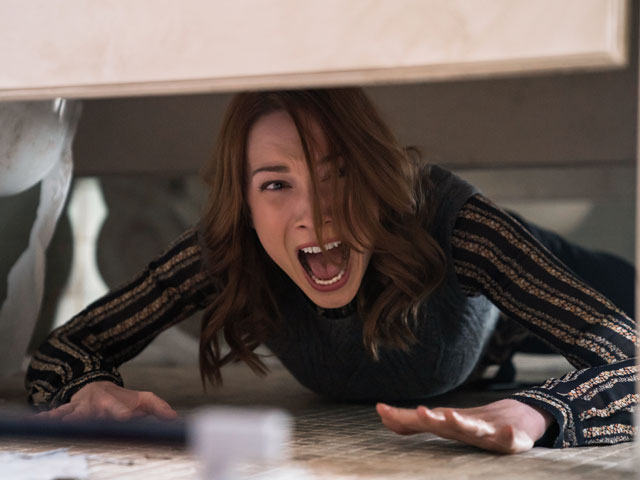
Resetting the Timeline: Halloween Begins
Cast: Judy Greer, Haluk Bilginer, Jamie Lee Curtis, Nick Castle, Will Patton, Toby Huss, Miles Robbins, Virginia Gardner, Andi Matichak
Director: David Gordon Green
Genre: Horror
Synopsis: In Halloween, Jamie Lee Curtis returns to her iconic role as Laurie Strode, who comes to her final confrontation with Michael Myers, the masked figure who has haunted her since she narrowly escaped his killing spree on Halloween night four decades ago.
Master of horror John Carpenter executive produces and serves as creative consultant on this film, joining forces with cinema's current leading producer of horror, Jason Blum (Get Out, Split, The Purge, Paranormal Activity).
Inspired by Carpenter's classic, filmmakers David Gordon Green (Stronger), Danny Mcbride (HBO's Eastbound & Down) and Jeff Fradley (HBO's Vice Principals) crafted a story that carves a new path from the events in the landmark 1978 film, and Green also directs.
Based on characters created by Carpenter and Debra Hill, Halloween is also produced by Malek Akkad, whose Trancas International Films has produced the Halloween series since its inception, and Bill Block (Bad Moms, District 9).
Curtis is joined on screen by Judy Greer (Jurassic World, Ant-Man) as Karen, Laurie's daughter who was taken away from her when Karen was a child, and who fluctuates between sympathy for her mother and frustration at the nonstop paranoia; newcomer Andi Matichak as Allyson, Karen's teenager who is attempting to navigate the rift between her mom and grandmother; Will Patton (TV's Falling Skies, Armageddon) as Officer Hawkins, who was a young cop the night Michael Myers was taken into custody 40 years prior; Haluk Bilginer as Dr. Sartain, the psychiatrist who's overseen Michael's incarceration for decades; Virginia Gardner (Hulu's The Runaways) as Vicky, Allyson's best friend since they were young girls; and stunt-man/performer James Jude Courtney (Far and Away), who portrays Michael Myers/The Shape. As well, Nick Castle (1978's Halloween) appears in a cameo as The Shape.
Halloween
Release Date: October 25th, 2018
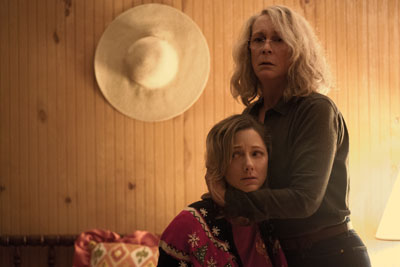 About The Production
About The Production
Malek Akkad"whose family's production company, Trancas International Films, has produced the Halloween series since its inception"was open to a fresh take on the story and found a likeminded creative partner in Jason Blum. His fellow producer, whose Blumhouse Productions"responsible for delivering smash-hits from Get Out and Split to the films in The Purge series"has a first-look deal with distributor Universal Pictures. Long impressed by Blum's ability to marry abject terror with impeccable quality, Akkad was keen to embark upon a project with a fellow filmmaker who had a deep passion for his father's co-creation…and someone who could help him breathe unexpected new life into the franchise.
Akkad gives us a bit of background on how it all began, an incredulous 40 years ago: "The original film came about when my father, Moustapha Akkad, and a gentleman named Irwin Yablans started a distribution company, Compass International Pictures. They were looking for some projects that they could self-finance and distribute and were fans of John Carpenter's early work: Assault on Precinct 13. They had a meeting with him, and he had a concept for a low-budget film called The Babysitter Murders. They took a risk, and the rest is history."
Carpenter remembers those early years. "The distributor asked me to make this film for 200,000 bucks, and I said, 'Sure I can. I just want creative control and my name above the credits.'" Reflecting on his creation with co-writer Debra Hill, Carpenter understands why audiences continue to be terrified by this embodiment of fear.
"Michael Myers, with his mask and his gas-station attendant's uniform, is a character who is between a human being and the supernatural. He is the ultimate force of evil. He is ruthless, and there's no reasoning or praying to God to save you. He has a single purpose, and that's to kill you. Michael Myers is a relentless force of nature. He's just coming, and you got to get out of his way."
A massive fan of the first Halloween, Blum feels that it's one of the most perfect horror films ever made…and had no interest in developing the project without running it by the director who'd inspired much of his own career. "Getting John Carpenter's blessing was a prerequisite for Blumhouse being involved in this movie," Blum reflects. "I wasn't going to pursue making a Halloween movie without him. So, the first person I went to was John. I asked him, 'Do you want to jump in?' He happily agreed to do just that."
Blum promised Carpenter"who calls Blum "the LeBron James of horror cinema""that they wouldn't move forward until he was happy with the director they had in mind…as well as the script that was being developed. To that end, Blum knew one filmmaker he thought might be interested. What he found was that David Gordon Green would not only want to helm Halloween, he'd want to collaborate with his longtime writing partners to craft the screenplay.
"We believe strongly at Blumhouse that you don't need a great horror-movie director to make great horror movies," the producer says. "You need a great movie director. I've admired David since his first film, George Washington, and I've reached out to him on multiple occasions hoping to lure him in. Halloween was when it finally happened. David fits very much into our philosophy: If you're a great director, we can help you make a great scary movie."
When it came to a chapter that would wake up the franchise, the producers leaned into this idea of this filmmaker not known for horror. "After having met so many directors and hearing several pitches, Miramax and I were able to bring Jason on board, and he deserves credit for bringing David to the picture," lauds Akkad. "I have been a fan of David's for years, and before even meeting I thought it would be an amazing opportunity. Jeff, Danny and David came in and pitched their take; the rest is becoming history."
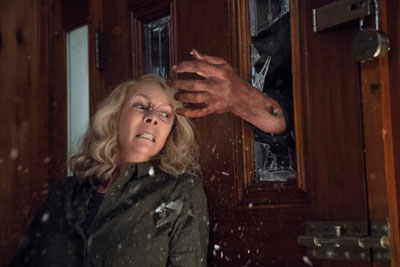 For Blum, it is the not knowing the why behind Michael Myers' motivation that is so terrifying. He also wholly agreed with the collaborators' idea that this should be Laurie's final confrontation with Michael, and that the film would reset the series. "This was 100 percent their pitch to me. The idea I brought to Jeff, Danny and David was to make a new Halloween movie. I told them they should imagine what would excite them and what they would most like to see. It was their idea to make this movie a continuation of the first Halloween."
For Blum, it is the not knowing the why behind Michael Myers' motivation that is so terrifying. He also wholly agreed with the collaborators' idea that this should be Laurie's final confrontation with Michael, and that the film would reset the series. "This was 100 percent their pitch to me. The idea I brought to Jeff, Danny and David was to make a new Halloween movie. I told them they should imagine what would excite them and what they would most like to see. It was their idea to make this movie a continuation of the first Halloween."
Green recalls that hearing from Blum was one of the more pivotal episodes of his career. "I remember that moment vividly, getting up in the morning and seeing this email from Jason asking to have me in the Halloween franchise. I immediately felt strange, like when you're standing on the edge of a cliff and your legs start to give out. It triggered a lot of my enthusiasm from when I was a kid and would sneak into movies I shouldn't have been watching. Halloween was the pinnacle of all of them."
Block, who has produced fare as varied as the thought-provoking District 9 and Elysium to the crowd-pleasing Bad Moms films, agreed with his fellow producers that Green was the ideal choice to direct the new film. "You see few directors move in genres as effortlessly as David has in the course of his career. He has this scholarly understanding and elevation of all that has come before. He has digested it and taken it a giant step forward; that's set up a new bar of excellence."
The producer shares that the matchup between Michael Myers and Laurie Strode is one for which audiences have waited a long time, and Green surpassed his expectations. "You go to a movie for an absolute thrill ride and for the surprise. The journey, particularly in this one"and this confrontation that has been brewing for 40 years between these two"upon his release is very satisfying."
Friends and Screenwriters: Fradley, McBride & Green
For writing partners Jeff Fradley, Danny McBride and David Gordon Green, the idea that the diehard fans of John Carpenter's 1978 masterpiece would not be the architects of the story that brings Halloween back to life was simply unthinkable.
Close friends and creative collaborators since their days studying film at North Carolina School of the Arts, their premise was deceptively simple, but ingenious: They posited what would happen if Michael Myers had been captured at the end of Halloween. What if Laurie and Michael weren't actually brother and sister, rather two strangers whose chance encounter changed the arc of both their lives? What would that do to the tale that began in the late '70s, and how would it change the narrative of both heroine and antagonist?
Like so many whose gateway drug to horror was Halloween, Fradley sums his feelings on an introduction to unknowable evil: "I remember Michael Myers scared the shit out of me. I didn't understand who this man with the white mask was, and that stayed with me." Reflecting on the movie's influence on his career, the writer and producer states: "I became obsessed with it as a kid, and that turned into my running around with a video camera"making our own version of Halloween."
McBride gives that he and his fellow writers had no interest in remaking Halloween, but were drawn rather to moving the story in a never-before-considered direction. "We thought that Laurie Strode was an interesting way in, so why don't we find a new timeline that can connect to the first movie…and explore a different path for her. We knew that if we were going to take a big swing like this, we should change things up so that we didn't walk down the same one others have."
As they wrote, they didn't yet have Carpenter's final blessing on their treatment, and had no idea if Laurie Strode herself, the fearless Jamie Lee Curtis, would be interested in returning to the character that has demarcated her professional career and elicited compassion and respect from legions of fans. "We tried to write a character that we thought would be interesting for her as an actress to portray," explains McBride. "I thought it was a cool way for her to revisit that character and, honestly, the death Laurie got in Resurrection just didn't seem suitable. It seemed like there was a way to beat that."
Script in hand and beads of sweat on their brows, the friends finally had the chance to bring their story to the master of horror himself"who has served as creative consultant on other chapters of Halloween, but hasn't since directed another film in the canon. "We met John when we pitched him our take," says McBride. "It was nerve-wracking to go to one of your idols and say: 'You created Michael Myers and Laurie Strode, and now we have the audacity to think we have an idea. Here's where the story could go from where you left it off…' He was very receptive to it and kind to us. That was the best we could have ever hoped for."
It was vital to the three men that Carpenter be on board. If not, they figured, what was the point? "If we were going to be as authentic and honorable to John's 1978 movie as we said we were, we had to have his blessing; we had to kiss the godfather's ring," sums Green. "The meeting went great, and he had some ideas and some concerns. Like any healthy creative conversation, we talked through it."
That's when the professionalism went out the door, and the guys went full fanboy. "At one point, his cell phone goes off while we're talking," Green adds, "…and it's the theme from Halloween. That's when I lost it. I kept it cool until then, but that's when I realised just where I was and who I was talking to. Then, once we knew he was on board, it was time for the next challenge of the conversation: to convince him to do the score."
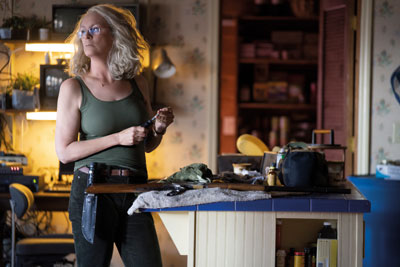 Fradley recalls the day the executive producer arrived on the Halloween set during shooting, and it was déjà vu for both producer and star: "When Carpenter came and met with Jamie, we were filming a scene where Laurie runs outside and faces Michael Myers. Jamie explained that she got the same feeling she had 40 years ago, and that it brought her back to Carpenter's set. There was a similar scene on that movie, and when she was filming our version, she had all those emotions rush back."
Fradley recalls the day the executive producer arrived on the Halloween set during shooting, and it was déjà vu for both producer and star: "When Carpenter came and met with Jamie, we were filming a scene where Laurie runs outside and faces Michael Myers. Jamie explained that she got the same feeling she had 40 years ago, and that it brought her back to Carpenter's set. There was a similar scene on that movie, and when she was filming our version, she had all those emotions rush back."
Little in their careers to-date could prepare the writers for the reunion of those who'd created the terrifying masterpiece so many years ago. "We devoured documentaries, books, everything we could get our hands on with regard to Halloween," McBride says. "We knew a lot about the making of it, but to see the personalities interact in person"to watch John and Jamie Lee greet each other, bullshitting with Nick Castle"was a small peek into three people who created something so iconic that it has stuck around for this long."
For his part, Green found himself tongue tied many days during production. "What I could never get past was the 12-year-old in me who was excited to be on set with Jamie Lee"mumbling his way through a conversation with John Carpenter and laughing hysterically when Nick Castle showed up. The realisation of so many of these childhood dreams was evident when I walked onto set. This was something I brought to this project, and a big part of my enthusiasm for it."
At the end of the day, there were only two people they knew they had to duly impress: Curtis and Carpenter. Fortunately, both were fans of the script and ultimately the film itself. "They've written some fascinating new characters, and they've cast the movie well," lauds Carpenter. "There are some good actors in this film, and the whole movie's just unusual. It has a quality to it. I told David: 'Man. This is as good as I've seen since we first did the first movie. You hit it out of the park.'" I'm excited for audiences to see this. It is going to scare the shit out of you. I guarantee it."
Laurie's Guardian Angel: Jamie Lee Curtis Returns
For more than two-thirds of her life, Jamie Lee Curtis has embraced the mantle of protector and guardian of Laurie Strode. In the late 1970s, the heroine that Curtis brought to life accomplished what few other on-screen women before her"long relegated to damsels in distress"would consider a probability or possibility in a horror film.
She survived.
Armed with only a coat hanger, knitting needle and the will to live, the teenager fought back against a faceless creature of pure evil who had violated her world and murdered her friends. Refusing to be a victim, the champion Curtis created alongside Carpenter and collaborator Debra Hill instantly changed the narrative on the silver screen. Women could, should and will strike back…and no man or boogeyman will stop them from fighting to the death.
While the actor, writer and activist has appeared in three other Halloween films since the 1978 original, Curtis assumed she'd said goodbye to bringing the character to the screen almost 16 years ago. When she first spoke with director Green, all that would change.
Refreshingly pragmatic, Curtis reflects that a 40-plus career in the entertainment business has taught her many things, the least of which is that she knows exactly who she is as a performer. "I'm almost 60, and I've been working since I was 19. Clearly what works for me"and what people want from me in my work"comes from that." She laughs: "You're not going to see me playing Queen Elizabeth. My gift is in the lack of knowing, and I learned that long, long ago."
That dogma has informed Curtis' attitude toward her personal and professional life, and she feels it speaks to Laurie's experience in the inaugural Halloween. The fact that the screenplay for the 2018 film so embraced and championed what she has long believed is what sealed Curtis' involvement in this production as star and executive producer.
The actor notes: "There's a Marisha Pessl novel I love called 'Special Topics in Calamity Physics,' and this character talks about what we think life is. And then she says we are wrong. She says: 'Life hinges on a couple of seconds you never see coming, and what you decide in those seconds determines everything from then on and you won't know what you're going to do until you're there.' That's life; that's a marriage; that's raising children; that's a horror movie."
Undoubtedly, Curtis has long held Laurie in her heart and understands why people are so connected to this fateful night. Discussing her first filmic role, she says: "Laurie Strode was a smart girl in high school just starting her life. She was probably studying for the SATs, looking at colleges, and then Michael Myers showed up. Life hinged for her on a couple of seconds she never saw coming. The rest of her life is the movie we're making now. Forty years later, this woman understands that Michael Myers will come back, and that she and her family need to be prepared…but nobody's listening."
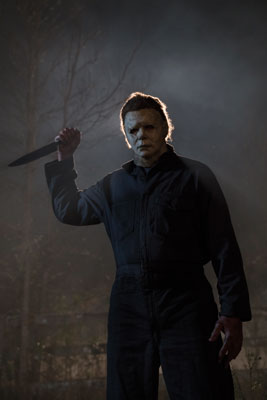 Fortunately for audiences, listen is exactly what Curtis did. Green had recently directed Curtis' godson in the movie Stronger, and the actor had a particularly gratifying experience on set. "Jake Gyllenhaal texted me and said his friend David Gordon Green wanted to speak to me about something regarding Halloween. Jake said that it was the best creative experience he'd ever had, and that he felt freer with David than he'd ever felt."
Fortunately for audiences, listen is exactly what Curtis did. Green had recently directed Curtis' godson in the movie Stronger, and the actor had a particularly gratifying experience on set. "Jake Gyllenhaal texted me and said his friend David Gordon Green wanted to speak to me about something regarding Halloween. Jake said that it was the best creative experience he'd ever had, and that he felt freer with David than he'd ever felt."
Understandably reticent to hear the nth Halloween pitch, Curtis approached the call warily. Still, fortune favors the brave. "David was exuberant and positive when we spoke. When he started to explain the idea to me, I said, 'Please don't. Just send it to me, and I will tell you from the opening sequence.'"
When she received Fradley, McBride and Green's script, Curtis fully understood what they were trying to do. "I saw how perfectly homage-y and new it was. I thought, 'That's cool, and I like it! That was how easy it was. It's its own movie with a complete history linked to the past. Yet, it's in its own story 40 years later. The two movies, side by side, are perfect bookends and complements"telling the same story with new generations in the same simple, clear, iconic way that Halloween was and continues to be."
Curtis was drawn to the writers' take of a woman who has spent her entire life, 365 days a year, preparing for the return of the monster who violated her world. That said, by refusing to be a victim to Michael Myers any longer, she has allowed him to define her existence. "Once a day, Laurie drives by that mental institution and calls the police officers who are supposed to have an armed guy on the perimeter," reveals the performer. "I'm sure Laurie sits in her truck from six o'clock in the morning until midnight.
"She is singular in her purpose, and in that sense, everything else has fallen away," Curtis continues. "Her child was taken from her, and friendships, fun"any sense of a life"has been removed in her pursuit to make sure that Michael Myers stays behind bars at the mental institution…or that he will be transferred to a maximum-security prison."
It wasn't lost on Curtis that the trio pitching her reminded her of lifelong friends she met in '78, and that both sets of filmmakers would shoot their passion project in less than one month. "The similarities are profound in two areas," she gives. "The first is that John Carpenter, [production designer] Tommy Wallace and Nick Castle are the original triumvirate of Halloween. They were friends who went to film school together, were in a band together called the Coup de Villes, and made a movie along with Debra Hill, who Laurie is the physical embodiment of. There was something very alive about that. No frills, no pampering. Just clean, guerilla filmmaking: 20 days, $200,000, boom."
She saw all of that in her new partners, and loved that her collaborators didn't initially recognise the parallels. "This is a group of best friends who went to film school together, made movies together and raised families together," Curtis says. "They, too, have come together to make a movie"no frills, bare bones; 28 days, boom. Those similarities are palpable in the process of making this movie"the exuberance of young people, the camaraderie of filmmakers who speak a creative language and who laugh a lot."
What her creative partners did see is the acting powerhouse who was equal parts champion, collaborator and risk taker. "What I didn't get until I met Jamie Lee is the cosmic energy that she brings when she enters the room," commends Green. "She brings the power of positivity like no one else. She's a ball of fire"on set early, there to connect with every collaborator, there to do the best job that she can. She brings 100 percent…from a fight scene to a dramatic scene to a scream one. It's just been a blast to work with her."
His producer marvels at a career with such depth and distinction. "Jamie's a great actress, so there's always room to return to previous work," Block lauds. "She took that energy and infused it into a terrific performance. She's like Liam Neeson in Taken. She's a full-on Terminator herself."
Haddonfield Players: Supporting Cast
To populate the world of Haddonfield, Illinois, in 2018 the production would turn to an eclectic and talented troupe of actors known for, alternately, dramatic and comedic work. With new faces joining and longtime friends reuniting, Halloween began its shoot.
Soon after the events of the first film, Laurie gave birth to a daughter named Karen. Curtis explains where we find the family, and what's happened to them since: "Karen is the child of a trauma victim, and she has suffered for it"as do many children of trauma. In Laurie's case, this is an unexplored psychological trauma. In 1978"in a small town like Haddonfield"there wouldn't have been a lot of therapy or real services offered to her. Like many people in America back then, she'd hear, 'Get on with your life,' and she tried to. It's just that the trauma was too big."
Cast as the daughter that Laurie parented with years of paranoia, weapons training and survivalist nightmares, was Judy Greer. The actor, who has deftly and equally navigated the worlds of television and film since her on-screen debut in the '90s, was thrilled to join Curtis on screen and the filmmakers behind it.
"When I found out that David and Danny were doing this, I was excited to work with them," commends Greer. "I also couldn't pass up the chance to work with Jamie Lee. Not only was she number one on my call sheet, she is the star of this movie and kicks all the ass. I loved that three guys wrote that script and made such a strong female lead."
Greer appreciated that Curtis and the writers had fleshed out such a meaningful arc for a woman whose existence has been defined by the trauma she suffered at a maniac's hand. The fact that the new Halloween gives Laurie a second chance at life"and to be proven right all along"was something to which Greer quite responded. "These are three strong female characters who are very protective of each other and of the life that they're trying to create. That said, Karen is emphatic that she won't raise Allyson the way that Laurie raised her."
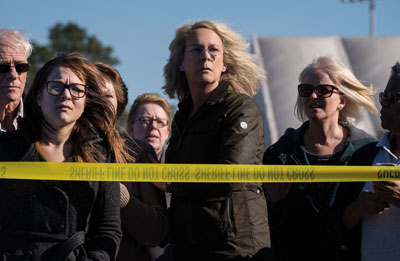 That amount of course correction, however, has resulted in Karen having a blind spot to the very real threat that Michael Myers poses, when"not if"he escapes. "Karen loves her mom, but she just can't be around her anymore," Greer reflects. "She wants to keep this bubble of safety and happiness around her daughter, and she doesn't want what happened to Laurie to play into the backstory of her daughter's life the way it has for my character. Karen tries to separate Allyson from Laurie because she doesn't want her mom to influence her in any way."
That amount of course correction, however, has resulted in Karen having a blind spot to the very real threat that Michael Myers poses, when"not if"he escapes. "Karen loves her mom, but she just can't be around her anymore," Greer reflects. "She wants to keep this bubble of safety and happiness around her daughter, and she doesn't want what happened to Laurie to play into the backstory of her daughter's life the way it has for my character. Karen tries to separate Allyson from Laurie because she doesn't want her mom to influence her in any way."
McBride reflects upon how Karen and Andi serve the narrative of the story: "Part of the idea of this film is to look at the long-term effects of experiencing violence and horror. That one fateful night when Laurie and Michael met has affected her daughter and granddaughter deeply and differently. It almost seems like it was dissecting Laurie in three different points of her life."
Allyson serves as a reminder to Laurie of the young, carefree woman she was before Michael Myers robbed her of a young adulthood. Much like Laurie was at that age, her granddaughter is primarily concerned with grades, babysitting gigs, boyfriends, the Halloween dance and any matter of decisions about which an average high school kid is fixated. That's what makes what happens to her family all the more horrifying. Fradley sums: "Allyson is the most like Laurie; she represents innocence…a young girl going about her day. As Laurie's daughter, Karen has been most affected by the violence."
Newcomer Andi Matichak tackles her first on-screen role as Allyson, who reflects both the naiveté and solid instincts that Laurie showed when we first met her"and is a reminder that unspeakable violence can happen to anyone. For the film's star, Matichak's casting sparked memories of another young actress…one who got her start years ago. Recounts Curtis: "Andi and I are playing grandmother and granddaughter in the same movie 40 years later, but neither one of us started to be actors. We both fell into it quite accidentally, and the fact that we'd both end up starring in a horror film is very interesting."
The similarities between the two performers unveiled themselves as Curtis got to know Matichak. "I was quite a bad student, and I came home from college and ended up auditioning for a low-budget horror film and getting the lead," explains Curtis. "That was my first movie: 'and introducing Jamie Lee Curtis.' Andi was an athlete who had a full college scholarship in Florida to play division-one soccer. She went to Greece to model because she ran into somebody who said, 'You're very pretty, and you could be a model.' Just like with me, a manager communicated with her family that he thought she could be a performer. She gave up her scholarship and became an actress in her first movie: Halloween."
That said, Curtis also sees a number of differences between these two characters. "Allyson is smart and capable, not as vulnerable and innocent as Laurie was. One part of the story that has evolved into something beautiful is that Laurie didn't believe in any of this threat. She was a complete innocent, which is why the story works so well. Allyson, on some level, is also innocent. She's been protected from her grandmother by her mother, who thinks Laurie is crazy. It's like two parallel stories; you're with Andi a lot of the movie, and then you're with Laurie. They are on opposite tacks, if you will."
Matichak appreciated the freedom and flexibility to find Andi in her own time. "She is on the brink of becoming a woman," notes the performer. "She's at that beautiful place where you're definitely an adolescent, more of a girl, but you're starting to act more like a woman and grow into
yourself. You're finding your voice and becoming who you're meant to be." The actress appreciated the flexibility her director allowed the cast on set, and she and Curtis ended up creating a significant backstory for Laurie. "Andi is in the National Honor Society, and that is something Laurie was also in for two years in high school. Jamie and I came up with that together, behind the scenes. I feel like the juxtaposition between the two of us is lovely, because you have a pre-terrorized Laurie and then now Laurie, 40 years later."
A peacemaker since she was a little girl, Allyson has been fiercely protected by her mom from the chaos, but still has the will and strength of her grandmother. "Part of the reason Allyson is such an old soul for 17 is that she's had to play mediator between mom and grandmother her whole life. When she is able to decide to have people in her life, she wants to see her grandmother more; that causes friction with her mother. She's been caught in the middle trying to mend the relationship between two strongly opinionated, lovely, bull-headed women." Matichak pauses, noting that those qualities are what make this film so special. "There are three strong women at multiple ages taking on an unstoppable force, and that is something incredible to be a part of."
For Green, it was crucial to design a situation where these three generations of women could all apply their battles, demons, anxieties and insecurities into one confrontation with Michael Myers. He gives: "To exhibit that physically, intensely with three very dominating actresses, the presence of their characters will blow the doors off the back of the theater. Those were a brilliant several days of my life."
One of the few other Haddonfield citizens who remembers just how terrifying that night was for Laurie is Officer Hawkins, played by brilliant performer Will Patton. A young cop the night that Dr. Loomis shot Michael Myers, Hawkins helped take the killer into custody that Halloween so long ago. He's seen Laurie devolve from a carefree teenager into a woman who calls the police on a daily basis to check in on the status of her would-be killer at Smith's Grove Sanitarium. She never rests, and nor can they.
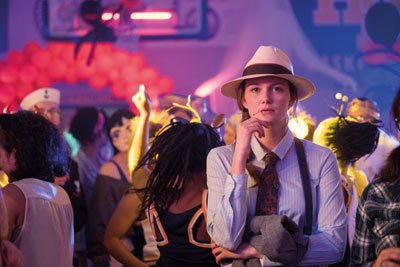 Patton describes what any of us would feel if we were confronted by The Shape himself. He recalls the day they faced off: "I'm very interested in what causes us to be afraid, and fear is a big part of being a human being. I like things that explore that. The night that I was first on set with Michael Myers and had a scene with him, I was genuinely fearful. I felt like there's something going on here that's very different than what I imagined."
Patton describes what any of us would feel if we were confronted by The Shape himself. He recalls the day they faced off: "I'm very interested in what causes us to be afraid, and fear is a big part of being a human being. I like things that explore that. The night that I was first on set with Michael Myers and had a scene with him, I was genuinely fearful. I felt like there's something going on here that's very different than what I imagined."
Brought on to portray Dr. Sartain was famed Turkish actor Haluk Bilginer, who stunned critics worldwide with his portrayal in 2014's Palme d'Or-winning Kis Uykusu (Winter Sleep). A young student of Dr. Loomis, the psychiatrist has been charged with studying Michael Myers at the sanitarium for years. Now that his patient will be transferred to a new maximum security facility, the doctor will be part of the transport team that brings Michael Myers to his final home.
As the team grappled with such dark material, the performers found it additive that Green kept his set light. Bilginer recalls their work: "We had a couple of Skype conversations when I was in Istanbul, and he asked me about the script, which I liked very much. Then when I met David over here? Oh, I loved him. He is such a great director and a great person. His presence is enough to give you energy. He oozes happiness on set, which is a very important qu
ality for a director to have. The actor feels safe, and feels he's in good hands." Portraying the British documentarians who make a deal with Dr. Sartain to attempt to interview Michael Myers are The Lears' Rhian Rees as Dana and Star Wars: The Force Awakens' Jefferson Hall as Aaron. Vloggers obsessed with the case of the Babysitter Murders from decades ago, they are certain that if they can just meet with Laurie and find out what happened that night, they will be able to shed new evidence on the crime and understand the unthinkable. When they procure The Shape's mask out of police-evidence storage and trigger Michael Myers at the sanitarium with their odious find, the duo prods into motion a series of events that will lead to Laurie facing Michael Myers for the very last time.
Supporting cast of the horror film includes Virginia Gardner of Hulu's The Runaways as Vicky, tasked with babysitting Julian (Jibrail Nantambu of AMC's Preacher) on Halloween night while her friends are at the high-school dance. She is joined by Miles Robbins (Blockers) as Vicky's boyfriend, Dave; Dylan Arnold (TV's When We Rise) as Andi's boyfriend, Cameron; Drew Scheid (Boy Erased) as Oscar, the most annoying friend of their group, who also has a secret crush on Andi; Toby Huss (AMC's Halt and Catch Fire) as Ray, Karen's sympathetic husband and Andi's dad; and Omar J. Dorsey (TV's Queen Sugar) as Sheriff Barker, who has seen the worst Haddonfield has to offer, and who is ready for the evil that's come back to town.
Behind the Mask: Michael Myers Comes Home
To portray Michael Myers, stuntman and actor James Jude Courtney inherited the mantle that not only terrifies audiences on sight, but frequently scared his fellow cast and crew during production. Courtney works alongside Nick Castle, who originate the role of "The Shape" in 1978's Halloween and spent time with Green on set as the production's "spiritual advisor," as he jokingly referred to himself.
Castle does appears in the film in cameo as The Shape, but he underscores that his good friend Courtney deserves credit for the lion's share of work on this screen. "Nick gave us instructions on little things"the way that Michael Myers turns his head or tilts it to observe a kill…or sits up at a 90-degree angle without using his hands," offers Green. "Those great little subtle characteristics were very important to the story we were telling."
Green describes exactly what he, and we, need from Michael Myers, and they primarily focus on construct: "There are several situations in the film where we see him in silhouette. He is unmasked, and we are trying not to reveal personality. I don't want know anything about Michael Myers. I don't want to feel sympathy for him or understand the mind that created the monster." He pauses: "I want him to disappear into the essence of evil."
What Green appreciated about Courtney's take on the character was the actor's interest in portraying Michael Myers with a neutral physicality and a workman ability. "We looked at references of cats in the wild"leopards, cheetahs, animals that don't rationalize anything other than what's in their path," the director says. "There are microscopic incentives that might direct them one way or another, but it's all predator and prey. He embraced a Michael Myers that was capable of emotionless rampage."
Curtis discusses just what makes "The Shape" so terrifying, reflecting that Michael Myers in that mask is a bit of a Rorschach test for all of us. She feels that we see in it what we are most afraid of. "This was John's invention to refer to this enigmatic everyman, this every threat," she states. "You're in every town, USA; Laurie Strode is every girl; and Michael Myers in that mask is that enigmatic lack of any human affect. He represents what Donald Pleasance as Dr. Loomis describes as 'pure evil.' 'The Shape' was John's way of referring to that enigma.
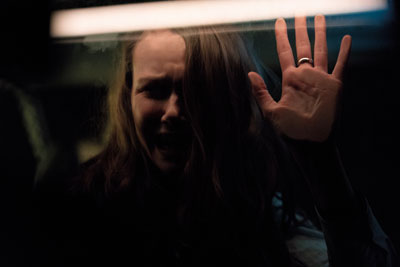 "There is no motivation," Curtis continues. "What's amazing about the creation of this character"and why it's had such longevity"is that there is no definition, no rhyme or reason, no analysis, no deep dive. There is nothing, and it is in nothing. In that state of nothingness, emptiness is either pure bliss or pure evil. Obviously, in his case…it's pure evil."
"There is no motivation," Curtis continues. "What's amazing about the creation of this character"and why it's had such longevity"is that there is no definition, no rhyme or reason, no analysis, no deep dive. There is nothing, and it is in nothing. In that state of nothingness, emptiness is either pure bliss or pure evil. Obviously, in his case…it's pure evil."
Courtney's colleagues appreciated that he was able to channel the enigmatic, methodical nature of Michael Myers. "It's his walk, his countenance, his posture," reflects Curtis. "Jim completely went there; something changed when he put that mask on. The combination of this lack of human response and his physical strength came out in a visceral and emotional way."
For Curtis, encountering this character again"lensing a scene that was deeply reminiscent of the one she'd lensed 40 years ago"proved a bit of mind-boggle. "The first night I shot on this film was the sequence where Michael Myers was clearly present near Laurie, and it had this heightened sense of alarm and concern. It reminded me of the first night we shot in Orange Grove on the first film"the sequence after Laurie has discovered the gruesome scene across the street and encounters The Shape for the first time. What I remembered when we were about to do the first take here"of that same type of sequence"was exactly how I felt when I was 19 years old. I remember we had only rehearsed the physical moves: where I would run out and fall, and how the Steadicam would follow me."
The performer appreciated that, just like Carpenter, Green had no interest in choreographing her decisions as an actor imagining what Laurie would do if she ever confronted her attacker again. "There are very specific beats you have to hit in a movie like this. You have characters that are vulnerable, people separated, as well as terrible fear and uncertainty about what's happening to them," she offers. "You have no idea what you're going to do in those situations, and it has to look organic, messy and real. There was something in the same way that I had done a bunch of emotional, intense character scenes, and then I felt like I was 19 again, asking myself: 'What am I going to do here?'"
Two Different Prisons: Design of the Horror
Production designer Richard A. Wright has worked alongside Green in that capacity since the director's inaugural film. From comedies and thrillers to dramas and satire, the filmmakers have long created fantastic worlds for their characters, and continue to operate with longtime friends and colleagues to do so.
It was key to the director to put these characters in an everyday world that we all recognize, one that is not extraordinary. "Stylistically, we used John Carpenter's film as our creative foundation," offers Green. "We're a sequel to that and no one else. In honor of that, and to spell out the simplicity that allowed us to go to these heightened places of terror, we wanted to establish a relatable sense of drama in these characters."
It's 40 years later, and that means "everything is a little more aged, a little textured. Something that was a bit more of a sterile suburb now has a saltier, seedier side."
Alongside Green and Wright, assistant director Atilla Salih Yücer, cinematographer Michael Simmonds and location supervisor/associate producer S. Scott Clackum began scouting for locations almost one year prior to principal photography. "We got to be there in the early stages of the script, discovering it as we went along," says Wright.
The 28-day shoot occurred in and around Charleston, South Carolina. While it was important for the designer to focus on the original film and take much of this production's lore from that, he didn't feel the need to be slavish to Carpenter's original creation. "In terms of the design, we started with what Laurie's house, her daughter's house and even her granddaughter's room look like," explains Wright. "We thought about what the character's gone through, the fact that she's never gotten over this experience. It has driven her to some sort of madness."
When it came to Laurie's nemesis, Wright takes us back to the start: "We find Michael Myers in the same place he was in at the beginning of the original film: a state hospital. This Smith's Grove State Hospital was a bit of a discovery. We happened upon this amazing checkerboard courtyard he's standing in the middle of."
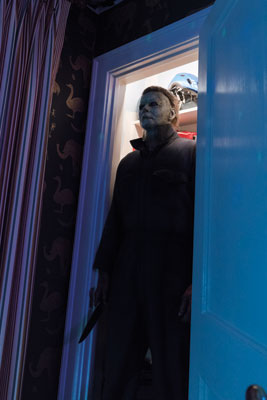 It was this scene that proved the most terrifying to producer Blum. He remembers the first time he watched it: "Michael Myers has an aura about him that very much scares the other inmates. When we first meet him, even in that context, he's extraordinarily threatening…even though he hasn't spoken in decades. He only grows more threatening through the course of the movie."
It was this scene that proved the most terrifying to producer Blum. He remembers the first time he watched it: "Michael Myers has an aura about him that very much scares the other inmates. When we first meet him, even in that context, he's extraordinarily threatening…even though he hasn't spoken in decades. He only grows more threatening through the course of the movie."
The bars and checkered patterns defined a number of the locations as the production went along; in turn, Wright began repeating those patterns in other sets. "You even see it in Laurie's house: she's caged in, just the way Michael Myers is," sums the designer. "He's locked behind bars in the state prison and when he comes upon Laurie, she's locked herself in a prison as well."
As the crew scouted locations and built sets, the design throughline was simply to show us at our most ordinary, shocked into an alternate reality when violence happens. "The goal is to present people in real situations," says Wright. "One of the things that makes the original film so horrifying is that this guy in a mask is killing kids who were just trying to have a good time. They're just doing things that normal high-school kids do."
When Wright was designing Laurie's farmhouse and shooting range, he leaned heavily on the film's star for input. As she's lived with this character for many years, Curtis had valuable recommendations regarding what Laurie's home would look like today. "Anytime an actor has input about their character, it brings new ideas to the table. She was a big force on set, in a very positive way. We had a few wallpapers hanging up in the location, trying to decide which one we liked," Wright recalls. "When Jamie saw them, she said, 'I always imagined Laurie would have floral wallpaper.'"
"It's Not Going to Bite You…" Special Effects & Makeup
One of the more popular people on set was Academy Award®-winning special-effects makeup designer Christopher Nelson, whose work in films such as Suicide Squad and the Kill Bill series to TV shows including American Horror Story and The Walking Dead have earned him praise from fellow artists and actors alike. In keeping with Green's direction that the scariest fears are the ones just out of camera's reach, Nelson kept up the delicate dance of showing our worst fears…without succumbing to an easy out of a gore-fest.
Like many of his cohorts, the SFX designer remains a huge fan of the original film. "There are things John did in that movie that were so groundbreaking and artistic, but still palpable and digestible for an audience" Nelson reflects. "I saw it when I was 10 years old, and it introduced me to a whole new genre of film. I attached myself to it and liked how scary and thrilling it was…as well as the fact that it happens right down the street."
It wasn't just the opportunity to work on Halloween that enticed the Oscar® winner to the project. It was the chance to collaborate with a director who gets Halloween that brought him aboard. "At the time John made the film, he wasn't known as a horror-genre director," says Nelson. "He was a filmmaker out of USC who loved Peckinpah and studied a lot of different genres. David's very similar; he just loves film, and that why he jumps genres."
From the moment that Nelson met with the producers, his knowledge and love of all-things Halloween were evident. "I did a break-down and told them my ideas for the design of the mask and other effects in the film…along with the concept that David had in his mind of how it's going to look," the designer recalls. "We just all clicked, and they realized how passionate I would be for the project."
When in doubt, Nelson drew inspiration from the creative decisions made by Tommy Wallace, Carpenter's production designer on the first film. "Tommy kept the mask very simple, but it was the way it fit on Nick Castle and the way he moved in it that affected the way he looked," explains Nelson. "You could never, ever re-create that face, that nothingness and that tragedy"the feeling you have when you look at that mask for the first time."
Although it's become a bit of urban legend, Nelson breaks down how the original mask came to be. "John sent Tommy out to get some Halloween masks. He got this Captain Kirk/William Shatner mask that was made by Don Post Studios, and John said, 'Well, change it…' They thought it looked eerie and creepy. Tommy ripped the sideburns and eyebrows off, cut the eyeholes bigger and spray-painted it white. He also sprayed the blonde hair brown. It ended up being this strange mannequin-like face"soulless, almost a great-white-shark face"that so well."
As a super-fan himself, Green approached design of the 2018 mask with the utmost respect. "The mask is a very sensitive subject in Halloween lore. For some reason people have decided to put their spin on it, and I'm not sure when or why that became something of interpretation. Christopher is an amazing Oscar®-winning effects makeup artist, and said, 'let's make the mask.' Granted, it's 40 years later and it's going to have cracks and deteriorated, but we both wanted to keep that beautiful melancholy character that is the mask. We decided not to put our spin on it, but simply re-create it."
Once Courtney was cast and Nelson and the new Shape had a chance to meet his SFX designer, Nelson was intrigued by the performer. "Jim has such a perfect stature, as well as a great face and head. As we approached the mask, I obviously wanted to base it off the original mask and give it that form, expression of tragedy and blankness of soul." Once Courtney was in full dress, the designer was blown away. "Jim moves like a great white shark. He just swims through the water, eats and he moves on; there's no rhyme or reason. Jim's performance has impressed me beyond belief. He just nails it."
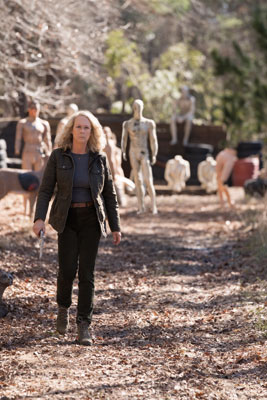 Nelson and Green wanted Courtney in the mask to look different in every shot in which he was photographed. They wanted the mask to be shapeshifting constantly but still maintain a form of tragedy and fear. Considering that it's been four decades since Michael Myers last donned it, the team had to take into consideration how the latex would change shape after so long in evidence storage. For Nelson, it was back to the homework. "I studied 40-year-old latex masks and how they decomposed. The latex gets brittle and it wrinkles; it warps and sags. I took all that into account but still tried to maintain that expression and form of the original."
Nelson and Green wanted Courtney in the mask to look different in every shot in which he was photographed. They wanted the mask to be shapeshifting constantly but still maintain a form of tragedy and fear. Considering that it's been four decades since Michael Myers last donned it, the team had to take into consideration how the latex would change shape after so long in evidence storage. For Nelson, it was back to the homework. "I studied 40-year-old latex masks and how they decomposed. The latex gets brittle and it wrinkles; it warps and sags. I took all that into account but still tried to maintain that expression and form of the original."
The rest of the crew got a kick out of warily watching Michael Myers on set. "Getting to see Jim Courtney and Nick Castle put on the mask of The Shape was a lot of fun," states production designer Wright. "Apparently when you put on that mask, you go to another place. They didn't even talk when they were in it, which is interesting to watch them get directed and just nod and shake their head calmly." He pauses, warily. "I've never put on the mask, but apparently it does something to you."
When it came to the bodies strung all over Charleston as Haddonfield, Nelson also knew what was required of him. "David and I had a lot of discussions about them as specific postcards. If you look at a lot of John Carpenter films, there are images you never forget," reflects Nelson. "There are still images with the victims after their death. They burn into our brain like terrifying postcards. When you walk out of the theater, you still remember them."
The process for the filmmakers was to start with the image Green needed to be seared into audiences' minds, and create that design to be shot on camera. "It's all about the lighting. Is there a glint in their eyes?" asks Nelson. "Is there a death-shriek expression on their face? To do this, we life-casted the actors whose characters are killed with specific expressions"re-sculpting them to give that dramatic effect. They were slightly over-accentuated and slightly stylized to give a terrifying inhumanity."
At least one of his cast-members was so impressed with Nelson's work that she had zero interest in getting any closer than she had to get. Matichak recalls the day she visited the designer's workshop and ran into a corpse: "The way it was sitting, its body and hands were propped up in a chair. Then its head was bent back in this way, so when you walked into the trailer, the first thing you see is a head looking at you upside-down. It was so horrific and real that I couldn't go near it. Chris said, 'Andi, it's okay. It's not going to bite you.' I told him, 'I think it will. It 100 percent will."
Green and DP Simmonds: Shooting the Film
Halloween's cinematographer, Michael Simmonds, has a history with both Blumhouse Productions and director Green. He's worked with Rough House Pictures on their HBO series Vice Principals, but partnered with Blum since 2010. "Michael and I go back to the Paranormal Activity movies together," says Blum. "He's one of the best DPs we've ever worked with. We've offered him almost every movie we made for years after Paranormal Activity 2."
Green reflects that being able to find somebody of that expertise in the horror genre"who also has the energy and enthusiasm he brings to this particular franchise"was amazing. "Every setup was a conversation. We had a great game plan going into it, but as the sunlight would change or an actor would have an idea, there became this organic process. When you have collaborators that aren't so precious and particular that they melt down whenever you change things"but are open to these opportunities and re-inventions"that's when the happy accidents happen." He pauses. "That's when the real jazz of filmmaking can kick in."
When structuring the shoot for Halloween, Green and Simmonds were not simply inspired by the look of movies from that era, but the manner in which they were shot. "David doesn't tend to get very cut-y with his films," says production designer Wright. "He likes to linger on a wide shot or even a close up longer than a lot of films do, and that comes from his love of '70s films."
His passion for lingering shots is yet another thing Green has in common with his horror mentor, and inspiration from the 1978 version is what he took in lensing 2018's film. Recalls Carpenter: "We were playing with brand-new toys on Halloween: widescreen Panavision, as well as something called the Pana-glide, which is a Steadicam rig for Panavision cameras. I've always been a fan of dolly shots, but they have limits to them. I noticed a Steadicam shot in a movie years earlier; it was a single take, and the freedom to move was unbelievable. So, they had a Panavision equivalent, which is the big Panavision lenses mounted on the operator as a gyroscopic camera. It had a unique drift and was unbelievable."
Throughout production, it was important for Green to host regular gatherings of the cast. Whether it was just for a coffee, a snack or a full meal, the troupe would talk through a scene at his home. "Sometimes we'd read them formally and make adjustments, and sometimes we would discuss the essence of what we were trying to achieve in a scene," the director notes. "Typically, after a couple takes on the days of production we would reassess. We'd see how things felt in the environment, in the wardrobe, in the moment and then make radical adjustments. That allowed us to throw each other curveballs and say, 'I've been doing it like this, and this is what we've talked about. What if we try something out of the box and let it loose?' I find those moments of vulnerability and uncertainty really valuable."
Curtis joins her fellow cast in appreciating the decisions Green made to get them out of their own head and shake things up on set with these curveballs. She explains a particularly poignant day: "There is a sequence where Laurie comes to Karen's house with the police. Karen finally understands that the threat is real, that Michael Myers has escaped, and her daughter is in jeopardy and they have to leave the house. The writing is as it should be, very specific, but here's an example where the combination of David, Michael and Atilla felt it needed work.
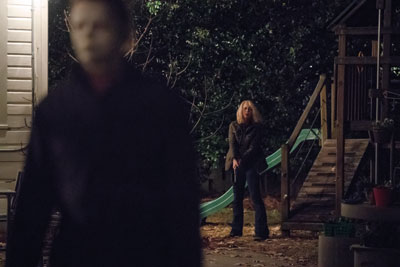 David said, 'It's too linear,' and these scenes are never linear. Trauma is not linear; trauma is fragmented. He had us speak gibberish to each other"just using one word and then not saying anything else. It was fascinating. He then had us say the same word over and over again to get to that chaos of a moment that on the page is very linear. In reality, it wouldn't be, because people don't speak that way."
David said, 'It's too linear,' and these scenes are never linear. Trauma is not linear; trauma is fragmented. He had us speak gibberish to each other"just using one word and then not saying anything else. It was fascinating. He then had us say the same word over and over again to get to that chaos of a moment that on the page is very linear. In reality, it wouldn't be, because people don't speak that way."
In turn, Simmonds adjusted and then got into it with a camera. Curtis found it fascinating to watch because that's how inventive and different Green continues to be. "It's a creative medium, and movies can become very static and very linear," she notes. "When he's getting into a scene, he's like a conductor through the monitor. I thought, 'Wow. He's invested. He is magical in that moment."
A Family Affair: Music of the Film
Not only did John Carpenter serve as creative consultant for the production, he brought his infamous skills as composer to the new Halloween. Alongside collaborators Cody Carpenter and Daniel Davies"with whom Carpenter has released three solo albums"the trio would not simply pay homage to work the composer began more than four decades ago, they would inventively update the sounds to serve Green's vision.
Producer Blum explains that what has kept Carpenter's original theme so timeless and haunting is that it remains so unexpected. "You don't associate that kind of keyboard music with a horror movie"as much as you wouldn't associate strings in a horror movie, which Hitchcock did in Psycho," he says.
His fellow producer appreciates the throw-back to another era, and the deep feelings of dread and terror the principal theme evokes. Block says: "The late-'70s synthesizer is an instrument that is not used so much anymore. That Moog synthesizer was a dominant instrument at the time. Alongside a lot of other technological music, it has been a bit forgotten. When it comes back, it's a classic aspect that really is effective."
Carpenter explains that his inspiration for the theme stretches back to his own childhood: "Back in 1963, my father taught me to play bongos. He taught me 5/4 time: ba, ba, ba, ba, bop, bop. Throughout the years, I've had that tempo in my head. So, I just played it on piano and rocked some octaves, and there it is. It's really simple, but it's jangly and gets in your head. I thought it would be perfect for the movie."
Green agrees with his producers when discussing the jarring simplicity. "The original theme that John created sits so comfortably with the film," he says. "It's almost a juvenile series of notes. You don't need the symphony to tell you how to feel. It's like Jaws; you have that simple back and forth, repetitive nature of a score. You don't need as much noise, accents and accessories when you have something that is so stripped-down and raw. At its musical essence, it scares the pants off of you."
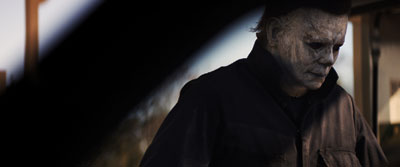 The director discusses what Carpenter brings to the new film as its composer: "It's one thing to do something derivative of that iconic Halloween theme or find a big orchestral composer and have him or her take it in their own direction and use creative license. But to have John's signature as a collaborator on the creation of the narrative"plus the casting and the sculpting of the production"the icing on the cake is this score. He's been playing music live forever, but he's recently toured with his son, Cody, and Daniel Davies. The three of them combined to create a once-in-a-lifetime opportunity of a Carpenter score for us." Carpenter welcomed the chance to "get into the director's head" and bring life to their shared conversations about bowed guitars, skittering electronic percussions and creepy piano-driven pieces. He explains his process for the music of 2018's Halloween: "The first step that my son, godson and I did with the score is called MIDI. We got the MIDI to the original score so we could work with essentially the notes and the feel. We applied all brand-new synth sounds to update it and make it sound different than the original does. Then we started at the Universal logo and began putting music in." He pauses. "Music is an improvisational situation for me. A couple of things we worked on and actually planned out, but what you see on the screen is mostly improvised."
The director discusses what Carpenter brings to the new film as its composer: "It's one thing to do something derivative of that iconic Halloween theme or find a big orchestral composer and have him or her take it in their own direction and use creative license. But to have John's signature as a collaborator on the creation of the narrative"plus the casting and the sculpting of the production"the icing on the cake is this score. He's been playing music live forever, but he's recently toured with his son, Cody, and Daniel Davies. The three of them combined to create a once-in-a-lifetime opportunity of a Carpenter score for us." Carpenter welcomed the chance to "get into the director's head" and bring life to their shared conversations about bowed guitars, skittering electronic percussions and creepy piano-driven pieces. He explains his process for the music of 2018's Halloween: "The first step that my son, godson and I did with the score is called MIDI. We got the MIDI to the original score so we could work with essentially the notes and the feel. We applied all brand-new synth sounds to update it and make it sound different than the original does. Then we started at the Universal logo and began putting music in." He pauses. "Music is an improvisational situation for me. A couple of things we worked on and actually planned out, but what you see on the screen is mostly improvised."
For the artist, the chance to have his bandmates score their first film alongside him was a joyous one. "Daniel, Cody and I have made three albums together, so we come up with new ideas and ways of doing things; that was the excitement for me," wraps Carpenter. "I got to work with my family, which is a big joy in my life at my age. Then I got to play with the original themes of Halloween, but remake them in a new way and that was a lot of fun."
Halloween
Release Date: October 25th, 2018
MORE





